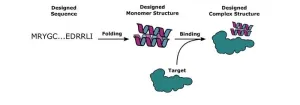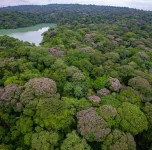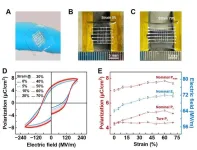(Press-News.org) EAST LANSING, Mich. – Sometimes, the best place to hide a secret is in broad daylight. Just ask the sun.
“The sun is more surprising than we knew,” said Mehr Un Nisa, a postdoctoral research associate at Michigan State University. “We thought we had this star figured out, but that’s not the case.”
Nisa, who will soon be joining MSU’s faculty, is the corresponding author of a new paper in the journal Physical Review Letters that details the discovery of the highest-energy light ever observed from the sun.
The international team behind the discovery also found that this type of light, known as gamma rays, is surprisingly bright. That is, there’s more of it than scientists had previously anticipated.
Watching like a HAWC
Although the high-energy light doesn’t reach the Earth’s surface, these gamma rays create telltale signatures that were detected by Nisa and her colleagues working with the High-Altitude Water Cherenkov Observatory, or HAWC.
Funded by the National Science Foundation and the National Council of Humanities Science and Technology, HAWC is an important part of the story. Unlike other observatories, it works around the clock.
“We now have observational techniques that weren’t possible a few years ago,” said Nisa, who works in the Department of Physics and Astronomy in the College of Natural Science.
“In this particular energy regime, other ground-based telescopes couldn’t look at the sun because they only work at night,” she said. “Ours operates 24/7.”
In addition to working differently from conventional telescopes, HAWC looks a lot different from the typical telescope.
Rather than a tube outfitted with glass lenses, HAWC uses a network of 300 large water tanks, each filled with about 200 metric tons of water. The network is nestled between two dormant volcano peaks in Mexico, more than 13,000 feet above sea level.
From this vantage point, it can observe the aftermath of gamma rays striking air in the atmosphere. Such collisions create what are called air showers, which are a bit like particle explosions that are imperceptible to the naked eye.
The energy of the original gamma ray is liberated and redistributed amongst new fragments consisting of lower energy particles and light. It’s these particles — and the new particles they create on their way down — that HAWC can “see.”
When the shower particles interact with water in HAWC’s tanks, they create what’s known as Cherenkov radiation that can be detected with the observatory’s instruments.
Nisa and her colleagues began collecting data in 2015. In 2021, the team had accrued enough data to start examining the sun’s gamma rays with sufficient scrutiny.
“After looking at six years’ worth of data, out popped this excess of gamma rays,” Nisa said. “When we first saw it, we were like, ‘We definitely messed this up. The sun cannot be this bright at these energies.’”
Making history
The sun gives off a lot of light spanning a range of energies, but some energies are more abundant than others.
For example, through its nuclear reactions, the sun provides a ton of visible light — that is, the light we see. This form of light carries an energy of about 1 electron volt, which is a handy unit of measure in physics.
The gamma rays that Nisa and her colleagues observed had about 1 trillion electron volts, or 1 tera electron volt, abbreviated 1 TeV. Not only was this energy level surprising, but so was the fact that they were seeing so much of it.
In the 1990s, scientists predicted that the sun could produce gamma rays when high-energy cosmic rays — particles accelerated by a cosmic powerhouse like a black hole or supernova — smash into protons in the sun. But, based on what was known about cosmic rays and the sun, the researchers also hypothesized it would be rare to see these gamma rays reach Earth.
At the time, though, there wasn’t an instrument capable of detecting such high-energy gamma rays and there wouldn’t be for a while. The first observation of gamma rays with energies of more than a billion electron volts came from NASA’s Fermi Gamma-ray Space Telescope in 2011.
Over the next several years, the Fermi mission showed that not only could these rays be very energetic, but also that there were about seven times more of them than scientists had originally expected. And it looked like there were gamma rays left to discover at even higher energies.
When a telescope launches into space, there’s a limit to how big and powerful its detectors can be. The Fermi telescope’s measurements of the sun’s gamma rays maxed out around 200 billion electron volts.
Theorists led by John Beacom and Annika Peter, both professors at Ohio State University, encouraged the HAWC Collaboration to take a look.
“They nudged us and said, ‘We’re not seeing a cutoff. You might be able to see something,” Nisa said.
The HAWC Collaboration includes more than 30 institutions across North America, Europe and Asia, and a sizable portion of that is represented in the nearly 100 authors on the new paper. That includes three additional Spartans: graduate student Daniel Salazar-Gallegos, Professor Emeritus James Linnemann and Kirsten Tollefson, a professor of physics and astronomy and associate dean in the Graduate School at MSU.
Now, for the first time, the team has shown that the energies of the sun’s rays extend into the TeV range, up to nearly 10 TeV, which does appear to be the maximum, Nisa said.
Currently, the discovery creates more questions than answers. Solar scientists will now scratch their heads over how exactly these gamma rays achieve such high energies and what role the sun’s magnetic fields play in this phenomenon, Nisa said.
When it comes to the cosmos, though, that’s part of the excitement. It tells us that there was something wrong, missing or perhaps both when it comes to how we understand our nearest and dearest star.
“This shows that HAWC is adding to our knowledge of our galaxy at the highest energies, and it’s opening up questions about our very own sun,” Nisa said. “It’s making us see things in a different light. Literally.”
By Matt Davenport
Read on MSUToday.
###
Michigan State University has been advancing the common good with uncommon will for more than 165 years. One of the world's leading research universities, MSU pushes the boundaries of discovery to make a better, safer, healthier world for all while providing life-changing opportunities to a diverse and inclusive academic community through more than 400 programs of study in 17 degree-granting colleges.
For MSU news on the Web, go to MSUToday. Follow MSU News on Twitter at twitter.com/MSUnews.
END
MSU scientists help discover the highest-energy light coming from the sun
2023-08-03
ELSE PRESS RELEASES FROM THIS DATE:
Outdoor air pollution may increase non-lung cancer risk in older adults
2023-08-03
Key points:
A cohort study of millions of Medicare beneficiaries found that chronic exposures to PM2.5 and NO2 over a 10-year period increased the risk of developing colorectal and prostate cancers.
Even in areas with low pollution levels, researchers found substantial associations between exposures to these pollutants and the risk of developing colorectal and prostate cancers, in addition to breast and endometrial cancers.
For immediate release: August 3, 2023
Boston, MA—Chronic exposure to fine particulate air pollutants (PM2.5) ...
University of Minnesota-led study links long-term artificial sweetener intake to increased body fat adipose tissue volume
2023-08-03
MINNEAPOLIS/ST. PAUL (08/03/2023) — Published in the International Journal of Obesity, University of Minnesota Medical School and School of Public Health researchers led a study on the relationship between dietary intake and cardiovascular disease risk factors.
Over 20 years, the research team examined people's regular dietary intake, paying particular attention to non-nutritive sweeteners commonly found in artificial sweeteners. They found that long-term consumption of aspartame, saccharin and diet beverages were linked to increased fat stores in the abdomen and fat within muscle. However, ...
Deep learning for new protein design
2023-08-03
The key to understanding proteins — such as those that govern cancer, COVID-19, and other diseases — is quite simple. Identify their chemical structure and find which other proteins can bind to them. But there’s a catch.
“The search space for proteins is enormous,” said Brian Coventry, a research scientist with the Institute for Protein Design, University of Washington and The Howard Hughes Medical Institute.
A protein studied by his lab typically is made of 65 amino acids, and ...
Scientists uncover a startling—and exploitable—coordination of gene expression in tumors
2023-08-03
AUGUST 3, 2023, NEW YORK – A Ludwig Cancer Research study has identified a pair of genes whose expression by a type of immune cell within tumors is predictive of outcomes for cancer patients and is linked to a vast network of gene expression programs, engaged by multiple cell types in the tumor microenvironment, that control human cancers.
Researchers led by Ludwig Lausanne’s Mikaël Pittet report in the current issue of Science that patients with higher expression of the gene CXCL9 in their tumor-associated macrophages had far better clinical outcomes than those with higher expression of a gene named SPP1 by the immune cells. Macrophages expressing the former ...
Fatal heart disease has plummeted since 1990, but progress has stalled
2023-08-03
After decades of decline, fatal coronary heart disease may rise again unless Americans modify three major risk factors: smoking, drinking, and obesity.
A Rutgers study just published in American Heart Journal found that deaths from coronary heart disease among people ages 25 to 84 dropped to 236,953 in 2019 from 397,623 in 1990, even though Americans’ median age increased to 38 from 33 over the last three decades.
Between 1990 and 2019, the US age-standardized coronary heart disease mortality rate per 100,000 fell from 210.5 to 66.8 for females (4 percent decline per year) and from 442.4 to 156.7 for males (3.7 percent decline per year). However, the decline has slowed significantly ...
UCF, MIT designing technology to fight bacterial infections, improve aquaculture farming
2023-08-03
UCF, MIT Designing Technology To Fight Bacterial Infections, Improve Aquaculture Farming
BY SUHTLING WONG | AUGUST 3, 2023 11:11 AM
UCF and MIT researchers are using farm-raised seafood as a model to create new technologies that fight pathogenic bacteria.
University of Central College of Medicine microbiologist Dr. Salvador Almagro-Moreno and Massachusetts Institute of Technology's Dr. Otto Cordero were recently awarded a grant from the National Science Foundation to create synthetic microbiomes – communities of microorganisms – that will better protect aquatic environments from bacteria.
The team ...
Researchers discuss the ethical challenges of studying DNA from a 18th–19th century African American community
2023-08-03
A population genetics team recently identified the genetic relationship between over 40,000 23andMe users and a population of enslaved and free African Americans that lived in Catoctin Furnace, Maryland between 1776–1850. Over the course of this study, the researchers considered how best to inform descendants and other genetic relatives of their genetic connection to the site. The group has published their considerations and the ethical questions they have encountered on August 3rd in the American Journal of Human Genetics.
“This study required us to consider several ethical issues that had not been explicitly addressed in the existing literature ...
Tropical trees use social distancing to maintain biodiversity
2023-08-03
Tropical forests often harbor hundreds of species of trees in a square mile, but scientists often struggle to understand how such a diversity of species can coexist. In a study published in Science, researchers at The University of Texas at Austin have provided new insights into the answer by uncovering a key characteristic of the spatial distribution of adult trees.
Combining computational modeling with data collected during a 30-year period, the researchers discovered that adult trees in a Panamanian forest are three times as distant from other adults of the same species as what the proverbial “the apple doesn’t fall far from ...
Ferroelectric material is now elastic
2023-08-03
A research group led by Prof. LI Runwei at the Ningbo Institute of Materials Technology and Engineering (NIMTE) of the Chinese Academy of Sciences (CAS) have proposed a "slight crosslinking" method that imparts elastic recovery to ferroelectric materials.
The study was published in Science.
Ferroelectric materials are very useful for applications such as data storage and processing, sensing, energy conversion, and optoelectronics, etc., making them highly desirable in mobile phones, tablets and other ...
Editorial: Turning the tide on obesity?
2023-08-03
In an Editorial, Cynthia Bulik and Andrew Hardaway highlight the recent advances in medical treatments for obesity and weight loss. “With the emergence of new, highly effective weight-loss drugs, might the ‘fat decades’ become a closed chapter in the history of public health?” ask the authors. The “obesity epidemic” is a global health concern, with more than a billion people affected by obesity and many more overweight. Although various environmental, biological, and behavioral factors have been implicated in obesity, few consistently effective treatments exist for the disease. Recently, however, new weight-loss ...



